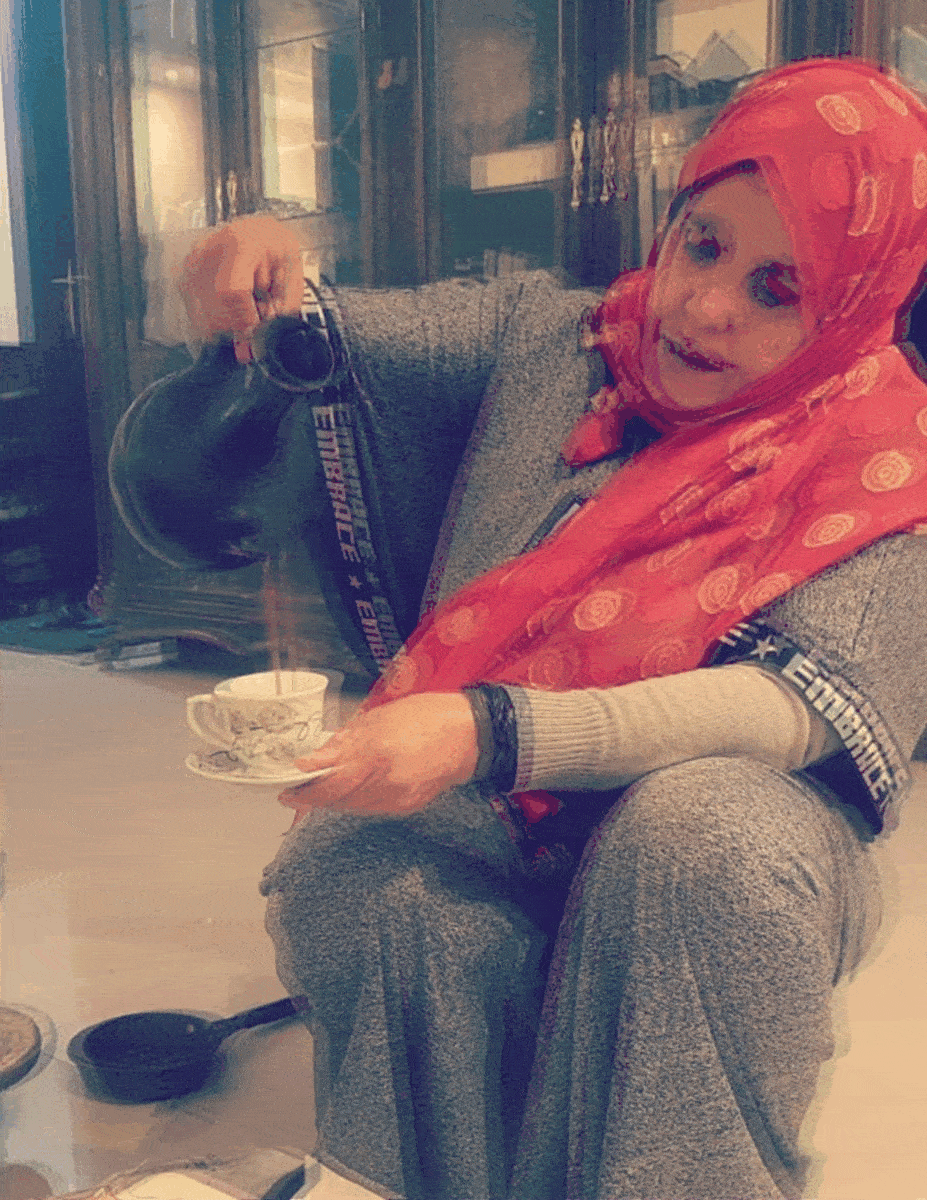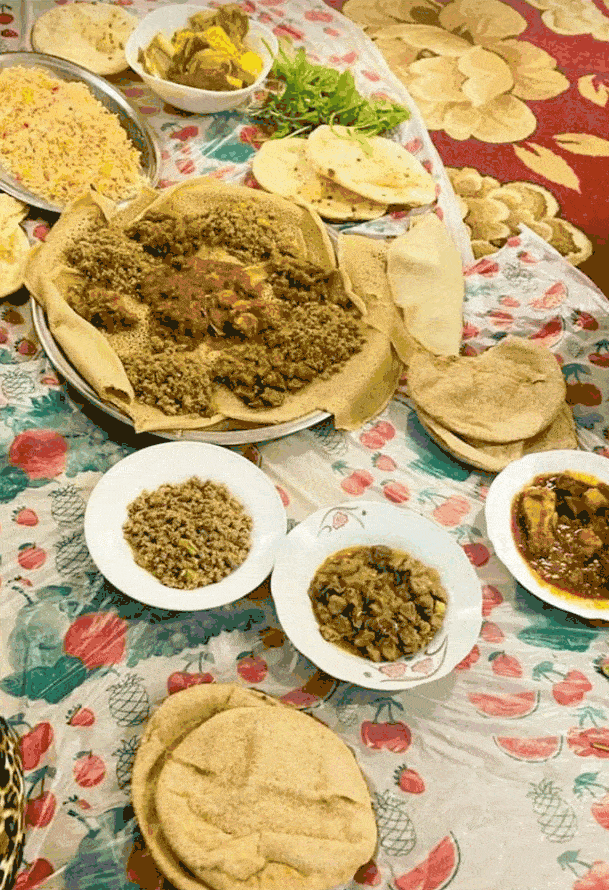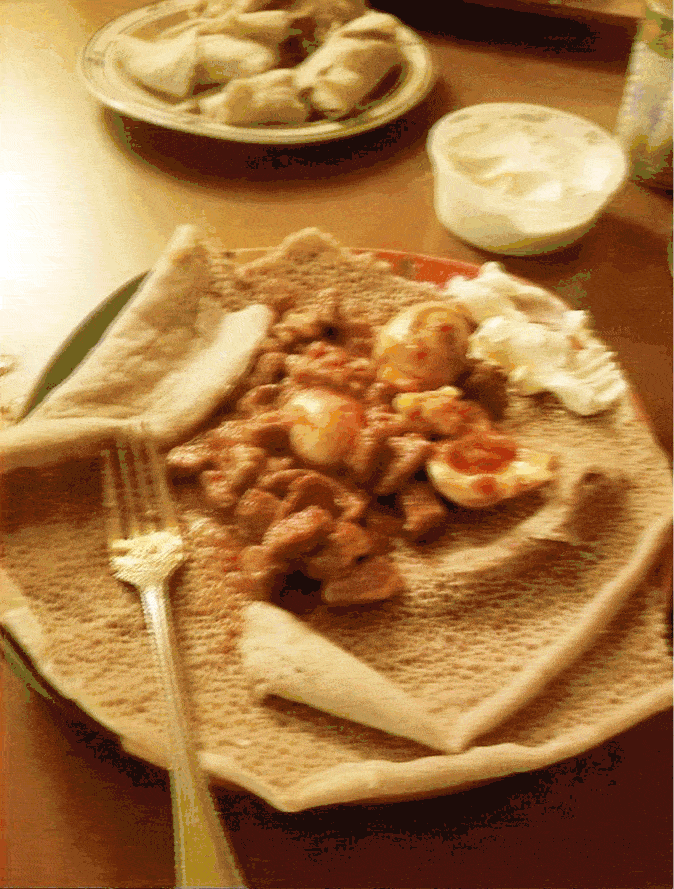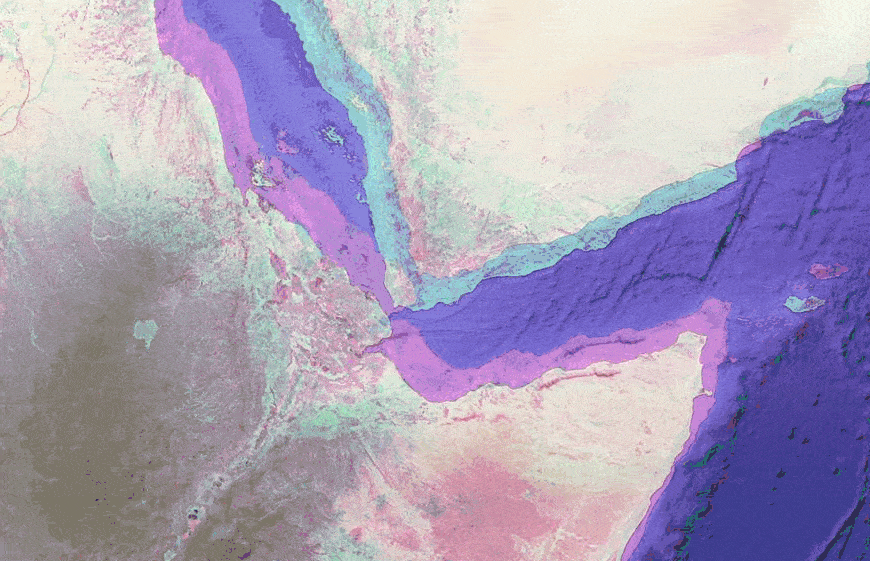THE BORDERING IDENTITY OF A NORTHEAST AFRO-ARABIAN
Iman Jamal Nagy
︎︎︎
Iman Jamal Nagy
︎︎︎
Often grappling with my identity, coming from a niche that most Africans and Arabs alike are unfamiliar with, I constantly struggle with answering the question, “what are you?” - Am I Ethiopian, am I Yemeni, am I neither, am I both?
In my hesitancy to explain in depth, I realize I am forced to express who I am per Western constructions of space, which I can only rationalize as bi-continental confusion.
In contemplating this, a slew of questions naturally arises:
Why does my African identity end at the Red Sea?i
Why does Arabian identity assume African exclusion?
Why are maps of Africa non-inclusive of African diasporas abroad?
We are confined to recognizable spaces to fit ideologies permeated by Western ways of knowing, of categorizing and “appropriate” placement. Can I simply be confined to pre-determined conventions of what an area-region should consist of visually and thus reflect its perceived cultural characteristics?
As an archaeologist and student of history, I find this remarkably two-dimensional and overlooking of the nuance of cultural complexity. In my case, the situation is more complicated than the desire for African inclusion as an Ethiopian-Yemeni.
Ethiopian-Yemeni Historical Identity Crisis
Ethiopia, like Egypt, often considers itself non-African; I suspect as a result of perceived elitism imposed via colonial racism and reinforced by (Ethiopian) Orthodox Christianity. Early colonial antiquarian “explorers” traveled to Northeast Africa and South Arabia in search of white people – their words – to justify the existence of ancient monuments understood to be outside the scope of non-European capability:
It may be asked, is there no other people that inhabit Abyssinia, but these two nations, the Cushites and the Shepherds? Are there no other nations, whiter or fairer than them, living to the southward of the Agaazi? Whence did they come? At what time, and by what name are they called?
– James Bruce, “Travels to discover the source of the Nile”, 1804 pg.397
Bruce introduced to the Western world what is now called the Book of Axum, a collection of liturgical documents written in Ge’ez discovered in the repository of the Maryam Tsion Church of Axum. These texts describe an event known as “Angaba”, a Ge’ez word for the populating of the “mixed people” of Ethiopia/Eritrea as largely descending from Palestine. This is indicative of Ethiopian/Eritrean identity being inextricably related to the Orthodox Tewahedo Church, in which it is believed that Ethiopians are largely of Hebrew descent (many Ethiopian names have Hebrew cognates). Tradition also states the last reigning monarchy of Ethiopia, the Solomonic Dynasty, of which the last was Emperor Haile Selassie, were direct descendants of Menelik, son of the biblical King Solomon and the Queen of Sheba, or Makeda in Ethiopian tradition. There are many versions of accounts describing why Menelik returned to Ethiopia, but central to each is that the Ark of the Covenant was brought with him and has been safeguarded in Axum ever since. This tends to be the tradition of Tigray and Amhara, of which my family belongs to, yet as Muslims we don’t ascribe to this. – The relationship to Yemen: In the Islamic tradition the Queen of Sheba is known as Bilqis and she reigned in the kingdom of Saba in Yemen. Ethiopian tradition sees her in many lights, sometimes as the queen consort of the snake king, Arwe of Axum, and sometimes as a great judge – large stone thrones can be seen all over the ancient city of Axum. In Yemen, and in Arabian traditions, she was a magical queen of Saba and therefore a pagan who eventually accepted Allah as the one true God. We grew up listening to traditional songs about this queen, Um Bilqis, of which you can find a link at the end of this piece.
Ethiopia is home to over 80 ethnic groups, many of which do not ascribe to this history, and who share deep roots with broader African language families and cultural traditions. However, we were taught that we are unrelated to them, and more so, different from them – they were Africans, we are Ethiopians, Yemenis, descendants of Sheba, children of mobile Yemeni merchants. Not Africans. But that doesn’t sum it up quite well enough, the implication behind that is those who are not attached to Biblical or Islamic traditions are in fact “primitive” in the extreme Western sense of the word – less than.
As mentioned before in the Islamic tradition, the Queen of Sheba is Bilqis, Queen of Saba, near Sana’a the capital of Yemen. Ancient Sabaeans lived in both Yemen and Ethiopia, with deep roots to Axum in Tigray. Likewise, Ethiopians lived in Yemen, at times ruling entire kingdoms and territories. My family comes from an area in the Ibb governate, whose ancient name was Zafar. Zafar was a very ancient city, occupied by many different faiths and ethnicities, yet it shares a plethora of “Ethiopian” traditions. It was, for a long time, ruled by the Axumites, most famously by Abreha, who in the Islamic tradition is the character in the Quran who plotted to destroy the Ka’aba sending Elephants from Ethiopia through Yemen. These are a few of many traditions that demonstrate a long standing tradition between these regions – these are the stories of my ancestors.
The ancient connections were stressed for a reason, and I realize why they are stressed now: my identity remains an ostracized minority group in both regions. In Ethiopia, we have Arab blood. In Yemen, we have African blood. We are dirty. We are referred to by a derogatory slur: مولد (muwalad). This might translate to something like mulatto, and if you try to translate it on google you’ll find attestations such as “mongrel” or “half-breed”.
Relationships Transcend Physio-Ideological Borders
These notions are reinforced by Western colonialism – and especially by the imposition of Western borders. These borders simultaneously reinforce political agendas resultative of Western political involvement while denying indigenous ideological spaces as valid or reflective of reality. Most of these physical and non-indigenous ideological borders in both regions did not exist prior to the colonization of Africa and the Middle East.
The relationship between these regions can’t be reduced and defined per the Western understanding of space-time;
– Yemen exists in Ethiopia and Ethiopia exists in Yemen –
as it has for thousands of years. My African identity does not end with a body of water, one that my ancestors crossed back and forth, attested to by archaeological finds dating to the prehistoric era and the plethora of oral traditions that we not only hear but absorb in our food and spirit. We mixed with Yemeni Arabs, while still retaining our African identities, which were not sacrificed as a result of mobility. They were, in fact, complimented and absorbed into Yemeni culture.
Bunna and Injera, called Laho in Yemen, constitute not only the cuisine of Ethiopia, but culturally, and what in anthropology a Westerner might understand as the construction of sacred spaces: both events are ceremonial and intrinsic to cultural identity:

Themes:
Wounds of Ruptures, Spatial Claims
Methods: Sonic, Experimental, Ocean as Method, Bordering, Food as Method
References:
A list of historical resources for anyone that is interested in understanding the historical and archaeological history of Northeast Africa, specifically Ethiopia and Yemen.
Adams, W. Y. (1997). Anthropology and Egyptology: divorce and remarriage. Anthropology and Egyptology: A Developing Dialogue, 25-32.
Anfray, F. (1968). Aspects de l’archéologie éthiopienne. Journal of African History, 9, 345–366. And Fattovich, R. (2010). The development of ancient states in the northern Horn of Africa, c. 3000 BC–AD 1000: an archaeological outline. Journal of World Prehistory, 23(3), 145-175.
Anfray, F. (1972). The archeology of Axum in 1972. Paideuma , 60-78.
Anfray, F. (1990). Les Anciens Éthiopiens : siècles d'histoire.
Anfray, F. (1994). Considérations sur quelques aspects archéologiques des relations de l’Éthiopie et de l’Arabie antiques. Etiopia e oltre, Studi in onore di Lanfranco Ricci, 17-25.
Beckingham, C. (1961). Notes on an Unpublished Manuscript of Francisco Alvares: Verdadera Informaçam Das Terras Do Preste Joam Das Indias. In Annales d'Éthiopie (Vol. 4, No. 1, pp. 139- 154). Editions de la Table Ronde.
Beckingham, C. F. (2017). The Prester John of the Indies: A True Relation of the Lands of the Prester John, Being the Narrative of the Portuguese Embassy to Ethiopia in 1520, Written by Father Francisco Alvares. Volumes I-II (Vol. 1). Routledge.
Bent, J. T. (1896). The sacred city of the Ethiopians: being a record of travel and research in Abyssinia in 1893. Longmans, Green and Company.
Breton, JF (2011). Relations between Ethiopia and South Arabia: problems of architecture. In Annals of Ethiopia (Vol. 26, No. 1, pp. 53-77). Editions of the Round Table.
Bruce, J. (1804). Travels to Discover the Source of the Nile (Vol. 2). Ballantyne.
Butzer, K. W. (1981). Rise and fall of Axum, Ethiopia: a geo-archaeological interpretation. American Antiquity, 471-495.
Chittik, N. (1976). Communication de Neville Chittick Aksum 1973-1974. Excavations by the British Institute in Eastern Africa. In Annales d'Éthiopie (Vol. 10, No. 1, pp. 325-327). Editions de la Table Ronde.
Connah, Graham. (2007) "Historical archaeology in Africa: an appropriate concept?." African Archaeological Review 24.1-2 pg.35-40.
Curtis, M. C. (2009). Relating the Ancient Ona culture to the wider northern Horn: discerning patterns and problems in the archaeology of the first millennium BC. African Archaeological Review, 26(4), 327-350.
D’Andrea, C., Lyons, D., Haile, M., & Butler, A. (1999). Ethnoarchaeological approaches to the study of prehistoric agriculture in the highlands of Ethiopia. In The exploitation of plant resources in ancient Africa (pp. 101-122). Springer, Boston, MA.
Dessie, A. (2007). Primary and Current Prehistoric and Aksumite Archaeological Research in Ethiopia. In Annales d'Éthiopie (Vol. 23, No. 1, pp. 315-328). Editions de la Table Ronde.
de Villard, U. M. (1937). Note sulle influenze asiatiche nell'Africa Orientale. Rivista degli studi orientali, 17, 303-349.
Dozier, E. (1955). The Concepts of "Primitive" and "Native" in Anthropology. Yearbook of Anthropology, 187-202.
Earle, T. K., Preucel, R. W., Brumfiel, E. M., Carr, C., Limp, W. F., Chippindale, C., ... & Knapp, A. B. (1987). Processual archaeology and the radical critique [and comments and reply]. Current anthropology, 28(4), 501-538.
Fattovich, R. (1990). Remarks on the Pre-Aksumite period in northern Ethiopia. Journal of Ethiopian Studies, 23, 1-33.
Fattovich, R. (2000). The Aksum archaeological area: a preliminary assessment (Vol. 1). Istituto Universitario Orientale, Centro Interdipartimentale di Servizi per l'Archeologia.
Fattovich, R. (2009). Reconsidering Yeha, c. 800–400 BC. African Archaeological Review, 26(4), 275-290.
Rodolfo Fattovich's Pottery Comparisons. (n.d.). doi:10.2307/al.ch.document.beaks 020222
Finneran, N. (2005). The Archeological Landscape of the Shire Region, Western Tigray, Ethiopia. In Annales d'Ethiopie (Vol. 21, No. 1, pp. 7-29). Editions de la Table Ronde.
Finneran, N. (2007). The archaeology of Ethiopia. Routledge.
D'ANDREA, A. C., Haile, M., Butler, E. A., & Lyons, D. E. (1997). Ethnoarchaeological research in the Ethiopian highlands. Nyame akuma, (47), 19-26.
Harrower, M. J., & D’Andrea, A. C. (2014). Landscapes of state formation: Geospatial analysis of Aksumite settlement patterns (Ethiopia). African Archaeological Review, 31(3), 513-541.
Huntingford, G. W. B. (Ed.). (1980). The periplus of the Erythraean Sea (Vol. 151). Ashgate Publishing, Ltd.
Japp, S., Gerlach, I., Hitgen, H., & Schnelle, M. (2011, January). Yeha and Hawelti: cultural contacts between Sabaʾ and DʿMT—New research by the German Archaeological Institute in Ethiopia. In Proceedings of the Seminar for Arabian Studies (pp. 145-160). Archaeopress.
Kirwan, L. (1972). The Christian Topography and the Kingdom of Axum. The Geographical Journal, 138(2), 166-177.
Littmann, E. (1907). Preliminary Report of the Princeton University Expedition to Abyssinia. Zeitschrift für Assyriologie und Vorderasiatische Archäologie, 20(1), 151-182.
Littmann, E. 1913 Deutsche-Axum Expedition. Berlin: Reimer.
McCrindle, J. W. (Ed.). (1897). The Christian topography of Cosmas, an Egyptian monk (Vol. 98). Hakluyt Society.
Munro-Hay, S. C. (1989). Excavations at Aksum: an account of research at the ancient Ethiopian capital directed in 1972-4 by the late Dr. Neville Chittick.
Munro-Hay, S. C. (1991). Aksum: an African civilisation of late antiquity. Edinburgh University Press.
Momigliano, A. (1950). Ancient history and the antiquarian. Journal of the Warburg and Courtauld institutes, 13(3/4), 285-315.
Paribeni, R. (1907). Ricerche nel luogo dell’antica Adulis. Monumenti Antichi, Reale, 18, 438- 572.
Pirenne, J., & Maricq, A. (1961). Le Royaume Sud-Arabe de Qatabân et sa datation: d'après l'archéologie et les sources classiques jusqu'au périple de la mer érythrée. Le Muséon/Bibliothèque du Muséon.
Phillipson, D. W. (1995). Excavations at Aksum, Ethiopia, 1993–4. The Antiquaries Journal, 75, 1-41.
Phillipson, D. W., & Phillips, J. (2000). Archaeology at Aksum, Ethiopia, 1993-7, Volume II.
Phillipson, D. W. (2011). Foundations of an African Civilization: Aksum and the Northern Horn, 1000 BC-I300 AD, James Currey.
Ptolemaais, K., Berggren, J. L., & Jones, A. (2000). Ptolemy's Geography: An Annotated Translation of the Theoretical Chapters. Princeton University Press.
Salt, H. (1814). A voyage to Abyssinia.
Schnapp, A. (Ed.). (2014). World Antiquarianism: comparative perspectives. Getty Publications.
Sundström, R. (1907). Archaeological work at the ruins of Adulis and Gabaza.
Tellez, B. (1710). The Travels of the Jesuits in Ethiopia. J. Knapton.
Vrba, E. (1994). African Homo erectus: old radiometric ages and young Oldowan assemblages in the Middle Awash Valley, Ethiopia. Science, 264(5167), 1907-1910.
Wolf, P., & Nowotnick, U. (2010). The Almaqah Temple of Maqaber Gaʿewa near Wukro (Tigrai, Ethiopia). In Proceedings of.
Wolska-Conus, W. (1962). La topographie chrétienne de Cosmas Indicopleustès: théologie et science au VIe siècle. Bibliothèque byzantine/Etudes.
![]()
[i] Also questioning her African identity in her piece, see: WHO WILL BEAR WITNESS? by Maria Carrilho Aragão
[ii] To read more about water bodies, borders and Afro-Asia, see: THEY WHO DREAM OF WAVES: A CONCISE GUIDE TO AFRO-ASIA by Alfonse Chiu
Methods: Sonic, Experimental, Ocean as Method, Bordering, Food as Method
References:
A list of historical resources for anyone that is interested in understanding the historical and archaeological history of Northeast Africa, specifically Ethiopia and Yemen.
Adams, W. Y. (1997). Anthropology and Egyptology: divorce and remarriage. Anthropology and Egyptology: A Developing Dialogue, 25-32.
Anfray, F. (1968). Aspects de l’archéologie éthiopienne. Journal of African History, 9, 345–366. And Fattovich, R. (2010). The development of ancient states in the northern Horn of Africa, c. 3000 BC–AD 1000: an archaeological outline. Journal of World Prehistory, 23(3), 145-175.
Anfray, F. (1972). The archeology of Axum in 1972. Paideuma , 60-78.
Anfray, F. (1990). Les Anciens Éthiopiens : siècles d'histoire.
Anfray, F. (1994). Considérations sur quelques aspects archéologiques des relations de l’Éthiopie et de l’Arabie antiques. Etiopia e oltre, Studi in onore di Lanfranco Ricci, 17-25.
Beckingham, C. (1961). Notes on an Unpublished Manuscript of Francisco Alvares: Verdadera Informaçam Das Terras Do Preste Joam Das Indias. In Annales d'Éthiopie (Vol. 4, No. 1, pp. 139- 154). Editions de la Table Ronde.
Beckingham, C. F. (2017). The Prester John of the Indies: A True Relation of the Lands of the Prester John, Being the Narrative of the Portuguese Embassy to Ethiopia in 1520, Written by Father Francisco Alvares. Volumes I-II (Vol. 1). Routledge.
Bent, J. T. (1896). The sacred city of the Ethiopians: being a record of travel and research in Abyssinia in 1893. Longmans, Green and Company.
Breton, JF (2011). Relations between Ethiopia and South Arabia: problems of architecture. In Annals of Ethiopia (Vol. 26, No. 1, pp. 53-77). Editions of the Round Table.
Bruce, J. (1804). Travels to Discover the Source of the Nile (Vol. 2). Ballantyne.
Butzer, K. W. (1981). Rise and fall of Axum, Ethiopia: a geo-archaeological interpretation. American Antiquity, 471-495.
Chittik, N. (1976). Communication de Neville Chittick Aksum 1973-1974. Excavations by the British Institute in Eastern Africa. In Annales d'Éthiopie (Vol. 10, No. 1, pp. 325-327). Editions de la Table Ronde.
Connah, Graham. (2007) "Historical archaeology in Africa: an appropriate concept?." African Archaeological Review 24.1-2 pg.35-40.
Curtis, M. C. (2009). Relating the Ancient Ona culture to the wider northern Horn: discerning patterns and problems in the archaeology of the first millennium BC. African Archaeological Review, 26(4), 327-350.
D’Andrea, C., Lyons, D., Haile, M., & Butler, A. (1999). Ethnoarchaeological approaches to the study of prehistoric agriculture in the highlands of Ethiopia. In The exploitation of plant resources in ancient Africa (pp. 101-122). Springer, Boston, MA.
Dessie, A. (2007). Primary and Current Prehistoric and Aksumite Archaeological Research in Ethiopia. In Annales d'Éthiopie (Vol. 23, No. 1, pp. 315-328). Editions de la Table Ronde.
de Villard, U. M. (1937). Note sulle influenze asiatiche nell'Africa Orientale. Rivista degli studi orientali, 17, 303-349.
Dozier, E. (1955). The Concepts of "Primitive" and "Native" in Anthropology. Yearbook of Anthropology, 187-202.
Earle, T. K., Preucel, R. W., Brumfiel, E. M., Carr, C., Limp, W. F., Chippindale, C., ... & Knapp, A. B. (1987). Processual archaeology and the radical critique [and comments and reply]. Current anthropology, 28(4), 501-538.
Fattovich, R. (1990). Remarks on the Pre-Aksumite period in northern Ethiopia. Journal of Ethiopian Studies, 23, 1-33.
Fattovich, R. (2000). The Aksum archaeological area: a preliminary assessment (Vol. 1). Istituto Universitario Orientale, Centro Interdipartimentale di Servizi per l'Archeologia.
Fattovich, R. (2009). Reconsidering Yeha, c. 800–400 BC. African Archaeological Review, 26(4), 275-290.
Rodolfo Fattovich's Pottery Comparisons. (n.d.). doi:10.2307/al.ch.document.beaks 020222
Finneran, N. (2005). The Archeological Landscape of the Shire Region, Western Tigray, Ethiopia. In Annales d'Ethiopie (Vol. 21, No. 1, pp. 7-29). Editions de la Table Ronde.
Finneran, N. (2007). The archaeology of Ethiopia. Routledge.
D'ANDREA, A. C., Haile, M., Butler, E. A., & Lyons, D. E. (1997). Ethnoarchaeological research in the Ethiopian highlands. Nyame akuma, (47), 19-26.
Harrower, M. J., & D’Andrea, A. C. (2014). Landscapes of state formation: Geospatial analysis of Aksumite settlement patterns (Ethiopia). African Archaeological Review, 31(3), 513-541.
Huntingford, G. W. B. (Ed.). (1980). The periplus of the Erythraean Sea (Vol. 151). Ashgate Publishing, Ltd.
Japp, S., Gerlach, I., Hitgen, H., & Schnelle, M. (2011, January). Yeha and Hawelti: cultural contacts between Sabaʾ and DʿMT—New research by the German Archaeological Institute in Ethiopia. In Proceedings of the Seminar for Arabian Studies (pp. 145-160). Archaeopress.
Kirwan, L. (1972). The Christian Topography and the Kingdom of Axum. The Geographical Journal, 138(2), 166-177.
Littmann, E. (1907). Preliminary Report of the Princeton University Expedition to Abyssinia. Zeitschrift für Assyriologie und Vorderasiatische Archäologie, 20(1), 151-182.
Littmann, E. 1913 Deutsche-Axum Expedition. Berlin: Reimer.
McCrindle, J. W. (Ed.). (1897). The Christian topography of Cosmas, an Egyptian monk (Vol. 98). Hakluyt Society.
Munro-Hay, S. C. (1989). Excavations at Aksum: an account of research at the ancient Ethiopian capital directed in 1972-4 by the late Dr. Neville Chittick.
Munro-Hay, S. C. (1991). Aksum: an African civilisation of late antiquity. Edinburgh University Press.
Momigliano, A. (1950). Ancient history and the antiquarian. Journal of the Warburg and Courtauld institutes, 13(3/4), 285-315.
Paribeni, R. (1907). Ricerche nel luogo dell’antica Adulis. Monumenti Antichi, Reale, 18, 438- 572.
Pirenne, J., & Maricq, A. (1961). Le Royaume Sud-Arabe de Qatabân et sa datation: d'après l'archéologie et les sources classiques jusqu'au périple de la mer érythrée. Le Muséon/Bibliothèque du Muséon.
Phillipson, D. W. (1995). Excavations at Aksum, Ethiopia, 1993–4. The Antiquaries Journal, 75, 1-41.
Phillipson, D. W., & Phillips, J. (2000). Archaeology at Aksum, Ethiopia, 1993-7, Volume II.
Phillipson, D. W. (2011). Foundations of an African Civilization: Aksum and the Northern Horn, 1000 BC-I300 AD, James Currey.
Ptolemaais, K., Berggren, J. L., & Jones, A. (2000). Ptolemy's Geography: An Annotated Translation of the Theoretical Chapters. Princeton University Press.
Salt, H. (1814). A voyage to Abyssinia.
Schnapp, A. (Ed.). (2014). World Antiquarianism: comparative perspectives. Getty Publications.
Sundström, R. (1907). Archaeological work at the ruins of Adulis and Gabaza.
Tellez, B. (1710). The Travels of the Jesuits in Ethiopia. J. Knapton.
Vrba, E. (1994). African Homo erectus: old radiometric ages and young Oldowan assemblages in the Middle Awash Valley, Ethiopia. Science, 264(5167), 1907-1910.
Wolf, P., & Nowotnick, U. (2010). The Almaqah Temple of Maqaber Gaʿewa near Wukro (Tigrai, Ethiopia). In Proceedings of.
Wolska-Conus, W. (1962). La topographie chrétienne de Cosmas Indicopleustès: théologie et science au VIe siècle. Bibliothèque byzantine/Etudes.
[i] Also questioning her African identity in her piece, see: WHO WILL BEAR WITNESS? by Maria Carrilho Aragão
[ii] To read more about water bodies, borders and Afro-Asia, see: THEY WHO DREAM OF WAVES: A CONCISE GUIDE TO AFRO-ASIA by Alfonse Chiu
My cousin Zabeba pours bunna from a jebena – an indigenous coffee pot found all over Northeast Africa. This image was taken in Sana’a, Yemen. She, like me, is of mixed descent. We grew up hiding our Ethiopian identity in Yemen, and because both of us have a fairer complexion compared to the rest of our family, it was easier for us to pass. Both of us are proud to be Habashiya – which again is used as a derogatory slur by some Yemenis. When visiting family in Ethiopia, we were similarly out-casted – only the older generation who understood the complex cultural history between the regions understood what we are, and could even see the physical traits of our ancestral region in our faces.
Both staples of Ethiopian and Yemeni cultures, their enduring existence fosters the liminal spaces where cultural overlap takes place. Both cultures exist within each other in their most coveted traditions. If we remain confined to the conception of cultural positionality as static, why is it that aspects of Northeast African identity end with topographical borders, when these traditions are very much alive on the other side of the Red Sea?
Yemeni Lahoh served with Kay Wat (Amharic) or Zigny (Yemeni, Tigrinya). An extremely common dish in my household. Traditionally known as Injera in Ethiopia, it can be made from Teff, Sorghum, and a variety of other wheats and flours. Because Teff isn’t as widely used in Yemen, it is generally made from plain flour.


Archaeological Influence on Regional Borders
I wanted to become an archaeologist so that I could study my cultures, and I soon realized that my identity as an Ethiopian Yemeni was stifled by Western constructions of space – which were imposed by archaeological ideas. Imposed ideologies of space and positionality convolute archaeological methodology specifically in requiring Eurocentric strategies of knowing and perceiving ways of life that often exceed the limitations of Western approaches. This results in alternate realities, such as archaeological cultures, which often completely discredit indigenous ontologies as either irrelevant, primitive, or non-existent altogether.
Both Ethiopia and Yemen have rich archaeological heritage – meaning, there are a lot of ancient sites and ways of life still in use today. Both cultures maintain strong cultural relationships to their ancestors as ancient Arabs and Sabaens in Yemen (Yemen is often credited as being home of the Arabs) and Axum in Northern Ethiopia. As mentioned before, both places lay claim to be the kingdom of the Queen of Sheba. In both regions, cultural continuity is a lived actuality. This concept is highly contested in Western archaeological theory. Consequently, scholarship often reinforces notions of separation and otherness despite overwhelming affinity.
The Western episteme will have you up in arms about who and what came first, whether one region is the responsible “origin culture” of the other, and how cultural technologies were transferred and can be traced to a source. This reflects a Western worldview of linear development, superimposed onto a non-Western context, often with political consequences. Sociopolitical animosity is created as a result of the construction of ideological spaces, especially from the notion of origin. We can trace this to be consequential of colonial philosophies of Africa as an undeveloped and primitive land mass incapable of achieving Western notions of cultural hierarchy. This resulted in both regions not wanting to be associated with the other, and furtherly, neither region wants any association to Africa. Colonial agendas sought to demonstrate that Ethiopia received a sort of “cultural toolkit” from the Near East, implying that the Axumite Empire was the direct result of South Arabian (Yemeni) influence lacking an indigenous African inception. Likewise, the same colonial agendas sought to draw connections to Europe as responsible for Near Eastern achievements. Which, in regular words, basically means that anything monumental is foreign to both Africa and Yemen. And now, both cultures constantly bicker about who birthed who.
Map Experiment
I became curious as to how deeply we are conditioned to associate separation on topographical maps, to examine the limitations of our own perception. I offered two maps to a variety of people of no association to Northeast Africa or the Middle East, because I wanted to get a sense of perceived cultural distance from people who have little to no context of the regions.

What do you see - Distance? Struggle? Connection? Separation?
I think it’s important to ask ourselves why, and to allow ourselves to rethink our preconceived ideas of spaces.
Can I be both?
So, what if Western constructions of space were removed? How would this affect the archaeological record and in turn affect the construction and maintenance of indigenous identity in both Yemen and Ethiopia?
Am I capable of contextualizing myself outside of how I was conditioned both culturally and now academically as a student of history – to fit into compartmentalized units of traditions that are invented to fit a Western narrative of cultural development? The more I study, the more I realize the effort of Western ideology to promote separation. The separation is necessary in order to create the units which can then be categorized and plotted and made sense of – but whose sense?
I find it increasingly important to detach myself from the notion of a singular truth – a singular epistemology – a singular way of knowing and perceiving. Especially one that was forced upon my culture, and caused this deft of confusion I’m trying to make sense of. I can lament the contemporary realities as a result of colonial philosophies, and I can also find comfort in being given the opportunity to critically reflect on how these realities manifest in myself, in my field, and in my family.

Iman Jamal Nagy is a PhD student at UCLA studying Northeast African Archaeology. She
focuses on reintegrating indigenous knowledge systems and perspectives
into mainstream heritage studies, bridging cultural connections from
Egypt to the Horn of Africa.
︎ UCLA
︎ UCLA

